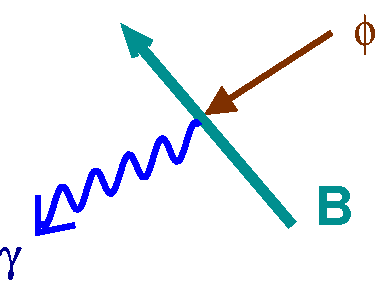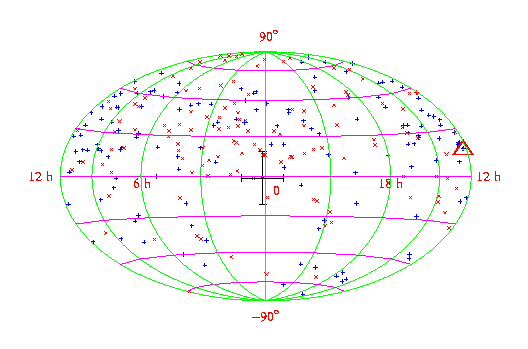.gif)
.gif)
![]() Elementary Particle Physics, strong interactions, Quantum Chromodynamics
Elementary Particle Physics, strong interactions, Quantum Chromodynamics
![]() Exclusive hadronic processes, Color Transparency and Nuclear Filtering
Exclusive hadronic processes, Color Transparency and Nuclear Filtering
![]() Ultra High Energy Cosmic Rays
Ultra High Energy Cosmic Rays
![]() Cosmic and Astrophysical Signatures of Low Scale Gravity Models
Cosmic and Astrophysical Signatures of Low Scale Gravity Models
![]() Cosmic Anisotropy in Radio Wave Polarizations
Cosmic Anisotropy in Radio Wave Polarizations
![]() Astrophysical signatures of axions and other light pseudoscalars
Astrophysical signatures of axions and other light pseudoscalars
![]() Physics beyond the Standard model
Physics beyond the Standard model
![]() Earth tomography using neutrinos
Earth tomography using neutrinos
![]() Partially coherent and partially polarized electromagnetic radiation
Partially coherent and partially polarized electromagnetic radiation
![]() Effective lagrangians for strong interactions, Skyrme model
Effective lagrangians for strong interactions, Skyrme model
![]() Relativistic bound state equations
Relativistic bound state equations
![]() 1+1 dimensional soliton models
1+1 dimensional soliton models
![]() Neural Networks, Weather forecasting using neural networks
Neural Networks, Weather forecasting using neural networks
![]() Applied Statistical analysis, remote sensing
Applied Statistical analysis, remote sensing
I have wide range of interests in High Energy Physics/Astrophysics. I have been interested in understanding the structure of fundamental particles such as the proton. These particles are bound states of elementary particles called quarks but their precise bound state structure remains poorly understood. The fundamental theory describing the interactions of quarks is called Quantum Chromodynamics or QCD. The theory has turned out to be extremely complicated and notoriously hard to solve. A fundamental problem associated with this theory is that quarks have never been seen in a free state. Furthermore so far it has not been possible to theoretically calculate the scattering processes involving protons except in some very special circumstances such that all the momenta involved in the process are very large. I am interested in understanding the electromagnetic structure of these particles. Since proton is not a point particle its interaction with photons is described in terms of a form factor. These form factors show a very simple structure experimentally, essentially obeying a simple power law as a function of the momentum at high energies. However even this basic power dependence is so far not understood theoretically. In collaboration with John Ralston from University of Kansas, USA, I am working towards a solution to this basic problem.
I have also been interested in the polarized radiation
from cosmologically distant sources. Recent
observations have indicated that optical polarizations
from distant quasars tend to be aligned with one another.
This effect is very surprising since the alignment is
seen for quasars which are very far away from one another and
are not expected to have any correlation over such large
distances. The effect is particularly pronounced in the
direction of the Virgo supercluster of galaxies. The
Virgo supercluster has been observed to have a magnetic field
of order 1 microgauss over very large length scales of
order 10 Mpc. I, along with graduate students Sukanta
Panda and S.
Sarala recently proposed that the alignment effect can be explained
if we assume that the quasars
are also emitting a hypothetical pseudoscalar particle
with negligible mass which is predicted by many extensions of the
Standard Model of particle physics but has not been observed
so far. In the presence of a background magnetic field
it decays into photons whose polarizations are aligned
along the background magnetic field. Hence we can explain the
alignment effect if the quasars emit such pseudoscalars
which decay while propagation through the Virgo supercluster. The
polarizations of photons produced in this manner will
be aligned along the direction of the background magnetic field
and hence will explain the alignment effect. This is
the only known explanation of this puzzling effect

Schematic illustration of how the pseudoscalar-photon mixing explains the observed alignment of optical polarization alignment in the direction of the Virgo Supercluster. Pseudoscalars (shown by the brown arrow) emitted by distant quasars decay into photons (shown by the blue wave line) in the presence of the background supercluster magnetic field (B). The photon produced in this process is polarized parallel to the background magnetic field and hence leads to an alignment of the observed polarizations.
The radio polarizations from distant active galactic nuclei also show an interesting anisotropic distribution. Here the variable of interest, beta, is the difference of the linear polarization angle and the galaxy alignment axis. Polarizations of radio waves undergo Faraday Rotation as they propagate through galactic magnetic fields. The effect of this Faraday Rotation is taken out of the data. The variable beta is found to be approximately pi/2 for most sources. In an isotropic universe beta would not have any dependence on the angular position of the source. However such an angular correlation is seen in the data at a high statistical significance. In the figures I show a scatter plot of sin(2 beta)

Scatter plot of sin(2 beta): sin(2 beta) negative is represented by blue pluses while sin(2 beta) positive is represented by red crosses. The dipole anisotropy axis, [(0 hours, 9 minutes),-1 degrees], is shown along with its error bars. The position of the Virgo supercluster is shown with a red triangle.

The figure shows the distribution
of the x = sin(2 beta) (1+g(RM)) on the celestial
sphere using equatorial coordinate
system, where RM is the rotation measure and beta
the polarization offset angle.
The function g(RM) is a gaussian and deviates
significantly from zero only if
RM is close to its mean value over the entire sample.
The variable x is shown at the
position of each source after averaging
over its nearest neighbours within
an angular distance of less than 18 degrees
(cos(theta) > 0.95). The anisotropic
distribution is clear from the
figure. Detailed numerical simulations
using circular statistics show that the
effect is significant at the level
of 4 standard deviations, i.e. the
probability is less than 0.005
% that this effect can arise due to random fluctuations.
The prefered direction of a dipole
fit obtained by the statistical simulations is also
shown in the figure by the solid
black cross. This prefered direction points,
within errors, directly opposite
to the Virgo supercluster. The effect can be explained
if we assume the existence of a
globally anisotropic background pseudoscalar field.
I have also been working on the
fascinating subject of ultra high energy cosmic rays. The origin of cosmic
rays at energies greater than 10 20 eV is very poorly understood.
Particles such as protons at energies greater than 1020 eV
are not able to propagate distances
larger than roughly 50 Mpc through intergalactic space since they are attenuated
by Cosmic Microwave Background Radiation. Since it is believed that astrophysical
sources capable of accelerating particle to these energies exist mostly
at distances larger than 50 Mpc the observation of large number of events
with energies in excess of 1020 eV is very puzzling. Cosmic
rays at such high energies are observed through the giant air showers that
they generate when the incident cosmic rays hits an air nucleus. The elementary
particle Neutrino can travel farthest distance in intergalactic space and
could be responsible for these events if its interaction with matter at
ultra high energies was strong enough. Within the standard model of particle
physics its interaction with matter is so weak that it will have very small
probability to interact with the air particles and hence will have very
little probability to generate the observed giant air showers. I recently
proposed that at energies relevant for these cosmic rays neutrino interaction
with matter is very strong within the recently proposed models which involve
extra spatial dimension. Hence these models provide an elegant solution
to the problem of the origin of ultra high energy cosmic rays.
.gif) Back To Home
Page of Pankaj Jain
Back To Home
Page of Pankaj Jain
.gif)